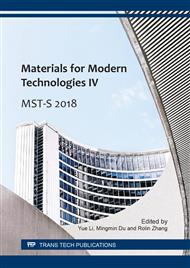[1]
Wang Y, Tang B H, Li F Y. The properties of self-formed diffusion barrier layer in Cu(Cr) alloy[J]. Vacuum, 2016, 126:51-54.
DOI: 10.1016/j.vacuum.2016.01.019
Google Scholar
[2]
Mishnev R, Shakhova I, Belyakov A, et al. Deformation microstructures, strengthening mechanisms, and electrical conductivity in a Cu–Cr–Zr alloy[J]. Materials Science & Engineering A, 2015, 629:29-40.
DOI: 10.1016/j.msea.2015.01.065
Google Scholar
[3]
Shakhova I, Yanushkevich Z, Fedorova I, et al. Grain refinement in a Cu–Cr–Zr alloy during multidirectional forging[J]. Materials Science & Engineering A, 2014, 606:380-389.
DOI: 10.1016/j.msea.2014.03.116
Google Scholar
[4]
Pan Z Y, Chen J B, Jin-Fu L I. Microstructure and properties of rare earth-containing Cu–Cr–Zr alloy[J]. Transactions of Nonferrous Metals Society of China, 2015, 25(4):1206-1214.
DOI: 10.1016/s1003-6326(15)63717-7
Google Scholar
[5]
Yu R P, Mi X J, Xie H F, et al. Research on microstructure and properties of Cu-Cr-Zr-Zn Alloy[J]. Applied Mechanics & Materials, 2013, 278-280:474-478.
DOI: 10.4028/www.scientific.net/amm.278-280.474
Google Scholar
[6]
Wang W, Kang H, Chen Z, et al. Effects of Cr and Zr additions on microstructure and properties of Cu-Ni-Si alloys[J]. Materials Science & Engineering A, 2016, 673:378-390.
DOI: 10.1016/j.msea.2016.07.021
Google Scholar
[7]
Yong P, Xia C D, Wang M P, Zhou L, et al. Effects of Zr and (Ni, Si) additions on properties and microstructure of Cu-Cr alloys[J]. Journal of Alloys and Compounds, 2014, 582:786-792.
DOI: 10.1016/j.jallcom.2013.08.146
Google Scholar
[8]
Wang S, Xie M, Wang S B, et al. Microstructure and Properties of Aged High Strength and High Conductivity Cu-Ag-Cr Alloy [J]. Rare Metals, 2014, 38(2):210-215.
Google Scholar
[9]
Song L P, Sun W, Yin Z M. Effect of Ag and Zr on microstructure and properties of Cu-Ag-Zr Alloy[J]. Heat Treatment of Metals, 2006, 31(8):46-48.
Google Scholar
[10]
Zhang C, Ding Z B, Xu Y S. Study on high temperature creep property of Cu-0.2Zr and Cu-3Ag-0.5Zr alloys[J]. Materials for Mechanical Engineering, 2011, 35(12):38-43.
Google Scholar
[11]
The effect of silver content on tensile strength and electrical conductivity of CuAg alloy contact wire bank[J]. YUNNAN METALLURGY, 2016, 45(4):62-65.
Google Scholar
[12]
Abib K, Azzeddine H, Tirsatine K, et al. Thermal stability of Cu-Cr-Zr alloy processed by equal-channel angular pressing[J]. Materials Characterization, 2016, 118:527-534.
DOI: 10.1016/j.matchar.2016.07.006
Google Scholar
[13]
Zhang C. Study on high temperature tensile properties of Cu-Zr and Cu-Ag-Zr[J]. China Technology, 2014(13):276-276.
Google Scholar
[14]
Chatterjee A, Mitra R, Chakraborty A K, et al. Comparative study of approaches to assess damage in thermally fatigued Cu-Cr-Zr alloy[J]. Journal of Nuclear Materials, 2016, 474:120-125.
DOI: 10.1016/j.jnucmat.2016.03.011
Google Scholar
[15]
Pond R C, Clark W A T, King A H, et al. Boundaries and interfaces in materials: The David A. Smith symposium[C]// Materials Week 97, Indianapolis, IN (United States), 14-18 Sep 1997. (1998).
Google Scholar
[16]
Krishna S C, Rao G S, Jha A K, et al. Strengthening in high strength Cu-Cr-Zr-Ti alloy plates produced by hot rolling[J]. Materials Science & Engineering A, 2016, 674:164-170.
DOI: 10.1016/j.msea.2016.07.063
Google Scholar
[17]
Hu G X, Cai X, Rong Y H. Fundamentals of Materials Science[M]. Shanghai: Shanghai Jiaotong University Press, 2009:218.
Google Scholar
[18]
Guo J T, Yuan C, Hou J S. Creep and fatigue - creep - environment interaction rules and mechanism of superalloys [J]. Transactions of Nonferrous Metals Society of China, 2011, 21(3):487-504.
Google Scholar
[19]
Feng D. Metal Physics[M]. Beijing:Science Press, 1999:565-568.
Google Scholar


